Imagine a garden filled with vibrant, colourful sweet peas, their delicate tendrils climbing skyward and their beautiful blooms filling the air with an enchanting fragrance. Growing sweet peas can transform any outdoor space into a magical haven, and with a little knowledge and care, you can enjoy these captivating flowers in your own garden. Whether you have a large garden or a small balcony, this guide will teach you everything you need to know about planting and growing sweet peas for a stunning display.
Key Takeaways
- Choose the perfect sweet pea variety for your garden
- Prepare soil and support structures
- Care for plants with consistent watering, fertilisation, and pest control to enjoy beautiful blooms & delightful scent
Choosing the Right Sweet Pea Variety
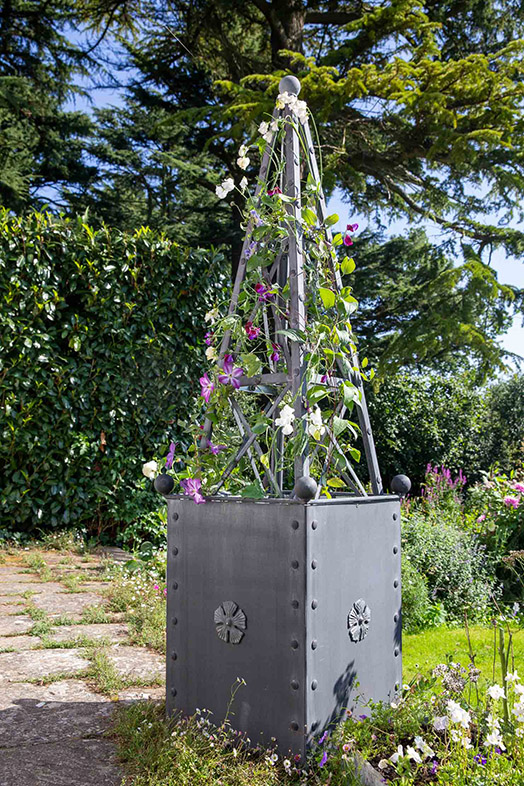
Selecting a suitable sweet pea variety for your garden ensures a fulfilling and successful gardening experience. There are plenty of delightful types to choose from, like the delightfully-scented annual sweet peas or the perennially-blooming everlasting pea. Consider factors such as the size, climbing capability, and fragrance of the sweet pea variety before making your decision.
Once you’ve chosen the perfect variety, you can find sweet pea seeds or seedlings at your local garden centre or online.
Let’s explore the various sweet pea varieties and their distinctive characteristics.
Dwarf varieties
Dwarf sweet pea varieties offer a compact and versatile option for those with limited space or who prefer container gardening. These compact plants have a bushy growth habit, eliminating the need for staking. With their abundant, brightly coloured flowers on strong stems, they often boast a delightful fragrance that will fill your garden with a gorgeous scent.
If you have a small garden or love having sweet peas in pots, dwarf varieties are the perfect choice for you.
Climbing varieties
Climbing sweet pea varieties provide an excellent way to add height and structure to your garden. Most sweet peas can reach an impressive 2m in height, creating a stunning visual impact in your outdoor space.
Climbing sweet pea plants, a type of climbing plants, thrive with vertical support, such as a garden obelisk or bamboo canes, allowing them to climb and produce more flowers throughout the season. With their enchanting fragrance and charming appearance, climbing sweet peas make a captivating addition to any garden.
Fragrant varieties
Fragrant sweet pea varieties bring an extra sensory delight to your garden, filling the air with a beautiful aroma. When selecting fragrant varieties, look for options known for their delightful scent and long-lasting blooms.
Care for these fragrant beauties by providing plenty of sunlight, water, and regular feed. When it’s time to harvest for seed, wait until the pods are full and the flowers have faded, then cut the stems at the base and remove the pods delicately.
Fragrant sweet peas are a perfect choice for those who appreciate the sensory pleasures of gardening, and buying sweet peas can be a delightful experience for those who love sweet peas.
Preparing to Plant Sweet Peas
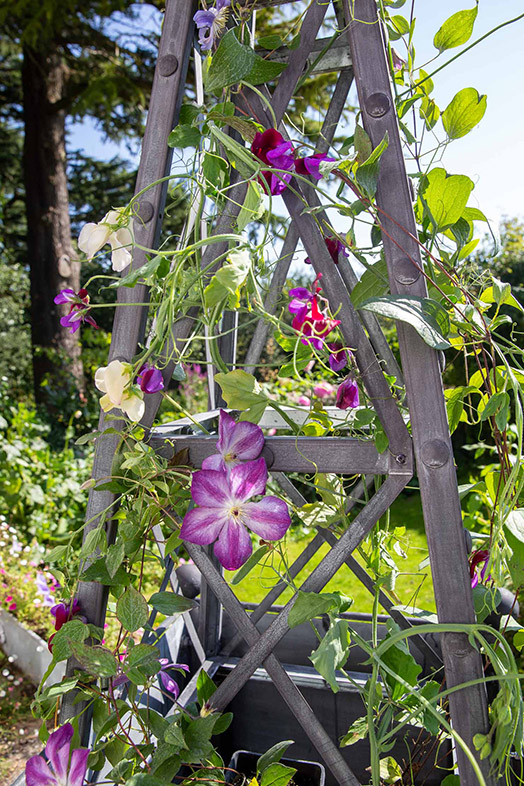
Appropriate garden preparation for sweet peas includes:
- Ensuring proper soil preparation
- Meeting sunlight requirements
- Soaking seeds before planting
- Preparing support structures for the plants
By following these steps, you can ensure the successful growth and bloom of your sweet peas, and effectively grow sweet peas in your garden.
Sweet peas thrive in fertile, well-drained soil that holds moisture, and they need a sunny spot in your garden to grow and flower optimally. Adhering to these guidelines sets the stage for the best environment for your sweet peas to thrive.
Soil preparation
Sweet peas thrive in nutrient-rich, moist, fertile soil. To prepare the soil, add organic material such as farmyard manure, which will improve its texture and nutrient content.
Adding a couple of buckets of compost to the planting area will enrich the soil even further and ensure it holds moisture during dry weather. With well-prepared soil, your sweet peas will have a strong foundation for healthy growth.
Sunlight requirements
Sweet peas need plenty of sunlight to grow and flower well. Look for a bright, sunny spot in your garden where they can receive at least 6 hours of direct sunlight each day.
Even if your garden only has partial shade, sweet peas can still grow, but their flowering may be less abundant. Ensuring adequate sunlight will help your sweet peas develop strong stems, vibrant blooms, and a delightful fragrance.
Pre-planting steps
A few pre-planting steps before sowing your sweet pea seeds can significantly enhance the success of germination. Soaking the seeds for 12-24 hours will help soften their hard seed coat, allowing water to penetrate and promote germination.
Additionally, prepare support structures, such as trellises or netting, for climbing varieties. These pre-planting steps will provide your sweet peas with the best possible start in your garden.
Sowing Sweet Pea Seeds

You can sow sweet pea seeds in either autumn or spring, depending on your climate and preferred blooming period. Autumn sowing allows for earlier blooms and stronger plants, while spring sowing is suitable for colder regions or if you missed the autumn sowing window.
Follow proper germination techniques, such as soaking seeds before planting or nicking the seed coat, to improve germination success. When appropriately sown and cared for, sweet peas reward you with gorgeous blooms in your garden.
Autumn sowing
Autumn sowing is an excellent option for those who want to enjoy early flowers the following Spring, such as earlier blooms and stronger sweet pea plants. Plant your sweet peas in moist, nutrient-rich soil and provide them with adequate support to help them grow and thrive.
As temperatures drop, protect your autumn-sown sweet pea seedlings from frost by using a cold frame or other protective measures. By sowing sweet peas in autumn, you’ll have a head start on a beautiful and fragrant garden display.
Spring sowing
If you live in a colder region or missed the autumn sowing window, spring sowing is a suitable alternative for growing sweet peas. The ideal time to sow sweet peas in spring is when the soil temperature is above 10°C (50°F). Follow the same germination tips as for autumn sowing, such as soaking seeds before planting or nicking the seed coat, to improve germination success.
With proper care and attention, your young sweet pea plants, spring-sown sweet peas, will reward you with a beautiful and fragrant display.
Germination tips
To improve the germination of your sweet pea seeds, consider nicking the seed coat or soaking the seeds before planting. Nicking the seed coat can break the hard outer shell, allowing water to penetrate and promote germination.
Soaking the seeds in damp kitchen paper for 24 hours before sowing can also encourage germination, although they can germinate in as little as two weeks without soaking.
By following these germination tips, you’ll increase your chances of growing healthy and vibrant sweet peas.
Transplanting and Supporting Sweet Peas
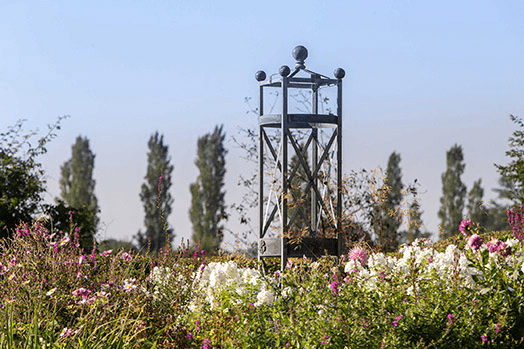
As your sweet pea seedlings mature, it’s the right moment to transplant them to your garden and ensure they receive the necessary support to thrive. Whether you sowed your seeds in autumn or spring, transplanting and supporting sweet peas properly is essential for healthy growth and beautiful blooms.
Adhering to the advice and approaches detailed in this section will bolster your sweet peas’ growth and turn them into a spectacular garden feature.
Transplanting tips
Before transplanting your sweet pea seedlings, it’s important to acclimate them to outdoor conditions to ensure their success. Plant the seedlings in rich, moist soil, spacing each group about 15cm apart for optimal growth.
The ideal time to transplant sweet peas is after the risk of frost has passed, usually 2 to 3 weeks prior to the last frost date. With proper transplanting, your sweet peas will establish themselves quickly and begin their journey towards a beautiful display.
Support structures
Sweet peas, particularly climbing varieties, require support structures to help them grow and thrive. Some excellent support options include:
- Obelisk
- Archways
- Trellises
- Netting
- Wigwams made of bamboo canes
Providing support structures not only helps sweet peas maintain their upright growth but also makes harvesting easier. By incorporating support structures into your sweet pea garden, you’ll ensure the plants grow strong and healthy.
Here at Arthur Jack our steel obelisks feature beautiful lattice-works, perfect for those winding tendrils. We have created two sizes, the smaller one standing at 1.4 metres above ground which fits snugly into our large planter to give additional height. The larger one stands at 2 metres high and even without climbing plants looks stunning in its own right.
Training sweet peas
Training your sweet peas is essential for encouraging bushier growth and stronger stems. Start by tying the sweet pea stems to support structures like obelisks or bamboo canes as they grow. Repeat the tying process every 7-10 days throughout the growing season to maintain healthy growth.
Additionally, pinch out the tips of sweet pea plants to promote the production of side shoots, resulting in a bushier and more robust plant. With proper training, your sweet peas will grow tall and strong, showcasing their beautiful blooms.
Caring for Your Sweet Peas

Providing adequate care is key to ensuring a flourishing and aesthetic display of sweet peas. This includes maintaining a regular watering schedule, fertilising the plants every couple of weeks, and keeping an eye out for pests.
Adhering to these care guidelines will result in your sweet peas gracing you with plentiful blooms and a captivating fragrance all season long.
Watering schedule
Consistent watering is crucial for the health and growth of your sweet peas. It’s essential to keep the soil moist, especially during hot or dry periods. Water sweet peas every few days or when the soil is dry to ensure the best results.
To promote healthy leaves, avoid over-watering, which can lead to mildew and other fungal issues. A well-watered sweet pea plant will produce vibrant blooms and a captivating fragrance.
Feeding
Feeding your sweet peas with the right fertiliser is essential for their growth and flowering. A high potash fertiliser or tomato feed applied every two weeks will provide the nutrients your sweet peas need to thrive.
Applying the fertiliser evenly and not too close to the stems of the plants is crucial for optimal growth. With proper fertilisation, your sweet peas will produce an abundance of stunning blooms and a delightful scent.
Pest control
Protecting your sweet peas from pests is essential for maintaining a healthy and beautiful garden. Common pests such as slugs and snails can be controlled using natural methods like companion planting, handpicking, or introducing natural predators like nematodes.
Harvesting and Enjoying Sweet Peas
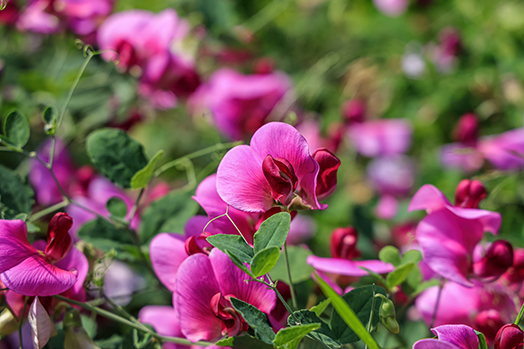
Sweet peas are not only beautiful in the garden but also make stunning displays in your home.
The tips in this section will enable you to relish the mesmerising beauty and scent of sweet peas, both in outdoor gardens and indoors.
Harvesting tips
To harvest sweet peas, wait until the seed pods are plump and the seeds are fully formed. Cut the stem just below the pod for optimal results.
Regularly harvesting your sweet peas will encourage more blooms and prevent seed pod formation, keeping your plants productive and beautiful throughout the season. With proper harvesting techniques, you’ll enjoy an abundance of sweet pea blooms.
Arranging sweet peas
Sweet peas make stunning arrangements for your home, with their vibrant colours and enchanting fragrance. To prolong their vase life, place sweet peas in a vase with sugar syrup, which will help keep them looking beautiful for longer.
For inspiration on displaying sweet peas, check out flower arranging videos or consult with a local florist. With a little creativity and care, your sweet pea arrangements will become a stunning focal point in your home.
Display ideas
There are endless ways to display sweet peas, whether in bouquets, table arrangements, or even floating in decorative bowls. Use your imagination and personal style to create unique displays that showcase the beauty and fragrance of sweet peas.
Experiment with different colours, textures, and support structures to design captivating displays that will delight your senses and bring a touch of the outdoors into your home.
Troubleshooting Common Sweet Pea Problems
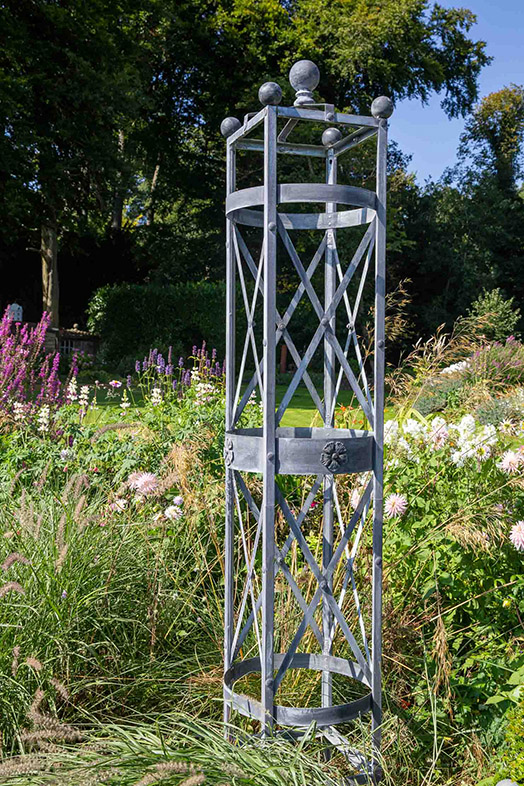
Cultivating sweet peas can occasionally pose challenges, such as:
- Promoting bud development
- Preserving leaf vibrancy
- Sustaining tall stems
- Preventing powdery mildew and other fungal issues
These factors are essential for maintaining healthy plants.
This section discusses some prevalent issues with sweet peas and offers solutions to guarantee a flourishing and attractive sweet pea garden.
Yellowing leaves
Yellowing leaves on sweet peas can be due to fungal issues or a lack of soil drainage. To ensure healthy leaves, make sure the soil is well-draining and that the plants have enough space to thrive.
If you notice yellowing leaves, remove any affected foliage and treat the plant with a fungicide to prevent further issues. By addressing yellowing leaves promptly, you’ll maintain the health and beauty of your sweet pea plants.
Short stems
Short stems on sweet peas can be improved by providing proper support, watering, and ensuring healthy seedlings. Use support structures like obelisks, trellises, stakes, or cages to help sweet peas grow tall and strong.
Additionally, here are some tips for caring for sweet peas:
- Water them regularly to promote healthy growth and prevent drought stress.
- Address any issues with short stems by providing proper support.
- Provide the necessary care, such as fertilising and pruning, to ensure strong and vibrant blooms.
Flowering issues
Flowering issues in sweet peas may be caused by insufficient sunlight or a lack of deadheading. Ensure sweet peas receive plenty of sunlight and deadhead spent flowers regularly to promote more blooms and prevent seed pod formation.
By addressing flowering issues and providing the necessary care, your sweet peas will reward you with a stunning and fragrant display.
Growing Sweet Peas in Containers
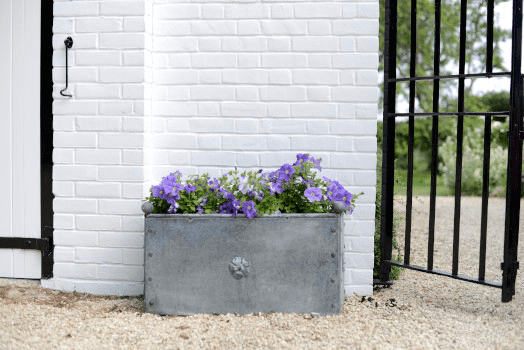
For gardeners with limited space or those desiring to enjoy sweet peas’ beauty on patios, balconies, or small areas, container gardening presents a flexible and space-efficient option. With the right container and proper care, container-grown sweet peas can thrive and provide a stunning display.
Container-grown sweet peas require a large container with good drainage.
Here at Arthur Jack we can provide a stunning planter to suit your size as we have six different size options available- all with ample drainage holes including special 6cm feet in each corner to keep the base clear. If it is a display that you would like to feature on a patio or a balcony for instance then fear not as we have two fabulous window boxes on offer, both with different dimensions, all finished with the same care and high-quality finish.
Container selection
Choosing the right container for your sweet peas is crucial for their success. Select a large container with drainage holes to accommodate the roots of the plants and ensure proper drainage.
Fill the container with a well-draining potting mix, such as a peat-free potting compost mixed with loam-based compost, and mix in a slow-release fertiliser for optimal growth.
By selecting the appropriate container, your sweet peas will have a strong foundation for growth and flowering.
Supporting container-grown sweet peas
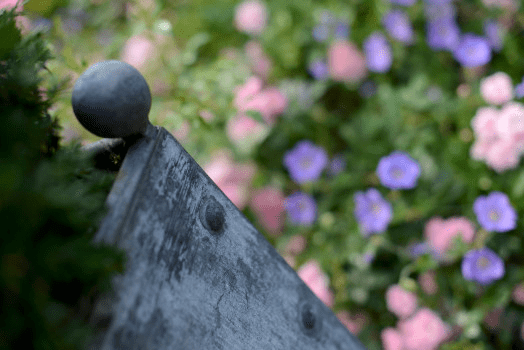
Container-grown sweet peas, especially climbing varieties, require support structures to help them grow and thrive. Provide support structures such as obelisks, trellises, wigwams, or climbing frames to ensure the plants grow strong and healthy.
By incorporating support structures into your container-grown sweet peas, you’ll create a beautiful and vibrant display that can be enjoyed in any outdoor space.
Summary
Growing sweet peas can transform your garden into a beautiful and fragrant haven. By choosing the right variety, preparing your garden, sowing seeds, transplanting and supporting, and caring for your sweet peas, you’ll enjoy stunning blooms and captivating scents throughout the season. Whether in the garden, in containers, or as part of eye-catching displays in your home, sweet peas are a delightful addition to any outdoor space. With the knowledge and tips provided in this guide, you’re now ready to grow and enjoy your very own sweet pea paradise.
Take a look at the Arthur Jack range of steel planters and obelisks in our online shop
Frequently Asked Questions
What is the secret to growing sweet peas?
The secret to growing sweet peas is planting them in a sunny spot with well-drained soil enriched with compost or manure, keeping the soil moist, and picking often. With these tips your sweet pea plants will thrive!
Do sweet peas climb on their own?
Yes, most varieties of sweet peas have tendrils that will ‘self-cling’ to supports and are easy to grow. However, some sweet peas may require tying in to support them.
Why are sweet peas so hard to grow?
Sweet peas are not hardy plants, and they need a lot of attention to thrive. Lack of sun, high temperatures or too much fertiliser can prevent them from blooming, and they also need a structure for support. To ensure your sweet pea flowers complete their full cycle successfully, it’s important to make sure the soil in the pot does not dry out too quickly.
Do I need a trellis for sweet peas?
Since Sweet Peas are vine plants, they need support to help them climb and bloom. Many structures work, such as obelisks, garden canes, wigwams, trellises or wire supports. Sweet peas wind tendrils around the supports and don’t usually need tying in, so a obelisk is a great choice for growing sweet peas.
What is the purpose of a garden obelisk?
Garden obelisks are an aesthetically pleasing way to create separate zones in modern and traditional gardens, providing a decorative alternative to fencing. They can be used to define a space, create a focal point, or add a touch of elegance to a garden. They are also a great way to add height and structure to a garden, and can be used to support climbing plants.


Leave a reply